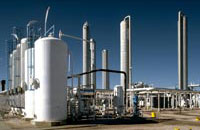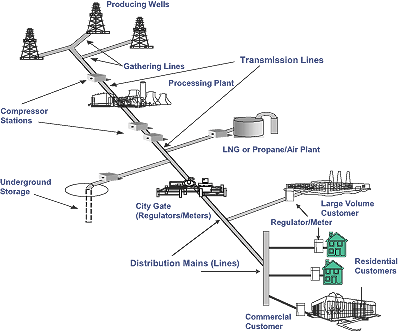Basic Information

Natural Gas STAR is a flexible, voluntary partnership that encourages oil and natural gas companies to adopt proven, cost-effective technologies and practices that improve operational efficiency and reduce methane emissions. Methane is emitted by oil production and all sectors of the natural gas industry, from drilling and production, through processing and storage, to transmission and distribution. Given that methane is the primary component of natural gas and a potent greenhouse gas, reducing these emissions results in many environmental, economic and operational benefits.
In 2006, in support of the Methane to Markets Partnership ![]() , EPA expanded the Program to include international operations, significantly increasing opportunities to reduce methane emissions from the oil and natural gas sector worldwide.
, EPA expanded the Program to include international operations, significantly increasing opportunities to reduce methane emissions from the oil and natural gas sector worldwide.
- Overview of Natural Gas STAR
- Overview of the Oil and Natural Gas Industry
- Major Methane Emission Sources and Opportunities to Reduce Methane Emissions
- Industry Links
Overview of Natural Gas STAR
What is Methane?
Methane is a potent greenhouse gas 23 times more powerful than carbon dioxide (CO2) in trapping heat in the atmosphere over a 100-year period and is emitted from a variety of natural and human-influenced sources. Methane is also a primary constituent of natural gas, an important energy source. To learn more, visit EPA's Climate Change and Methane Web sites.
Working collaboratively with the oil and natural gas industry in the United States since 1993, Natural Gas STAR has provided a framework to encourage partner companies to implement methane emissions reducing technologies and practices and document their voluntary emission reduction activities. Through this work, the oil and natural gas industry, in conjunction with Natural Gas STAR, has pioneered some of the most widely–used, innovative technologies and practices that reduce methane emissions.
Under the Methane to Markets Partnership![]() , EPA is building on the successes of the domestic program by launching Natural Gas STAR International, a global partnership with oil and natural gas companies. This expansion of the Natural Gas STAR Program significantly increases opportunities to reduce methane emissions from oil and natural gas operations worldwide.
, EPA is building on the successes of the domestic program by launching Natural Gas STAR International, a global partnership with oil and natural gas companies. This expansion of the Natural Gas STAR Program significantly increases opportunities to reduce methane emissions from oil and natural gas operations worldwide.
In addition, to learn more about the Natural Gas STAR Program, visit Join the Program and Guidelines to Participation. The Natural Gas STAR Program Fact Sheet (PDF) (4 pp, 1.1 MB, About PDF) provides an overview of the Program and why reducing methane emissions is so important in today's market place and environment.
Overview of the Oil and Natural Gas Industry
Oil and natural gas systems encompass wells, gas gathering and processing facilities, storage, and transmission and distribution pipelines. These components are all important aspects of the natural gas cycle—the process of getting natural gas out of the ground and to the end user which can generally be broken out into four sectors. Each sector is defined as follows:
- Production focuses on taking raw natural gas from underground formations.
- Gathering and Processing focuses on stripping out impurities and other hydrocarbons and fluids to produce pipeline grade natural gas that meets specified tariffs (pipeline quality natural gas is 95-98 percent methane).
- Transmission focuses on delivery of natural gas from the wellhead and processing plant to city gate stations or industrial end users. Transmission occurs through a vast network of high pressure pipelines. Natural gas storage falls within this sector. Natural gas is typically stored in depleted underground reservoirs, aquifers, and salt caverns.
- Distribution focuses on the delivery of natural gas from the major pipelines to the end users (e.g., residential, commercial and industrial).
In the oil industry, some underground crude contains natural gas that is entrained in the oil at high reservoir pressures. When oil is removed from the reservoir, associated natural gas is produced.
Major Methane Emission Sources and Opportunities to Reduce Methane Emissions
Oil and natural gas operations are a significant source of global methane emissions and account for approximately 18 percent of the total human-made sources according to the EPA, Global Anthropogenic Non-CO2 Greenhouse Gas Emissions: 1990 - 2020 report, dated June 2006. This inventory data further shows that the United States contributes 12 percent of the worldwide emissions from oil and natural gas systems. (See breakdown of top 5 methane emitting countries below.) Also, according to the EPA Inventory of U.S Greenhouse Gases and Sinks: 1990-2006, dated April 2008, oil and gas systems are the largest human-made source of methane emissions and account for 24 percent of methane emissions in the United States or 2 percent of the total greenhouse gas emissions in the United States.
Oil and Natural Gas Industry Methane Emissions: Worldwide - Top 5 Emitting Countries

Source: Global Anthropogenic Non-CO2 Greenhouse Gas Emissions: 1990 - 2020, USEPA, June 2006.
Note: The emissions data presented in the above graphic are the based on best available data from the above referenced report. For the most current country level inventory data visit the UNFCCC Web site![]() .
.
Methane emissions occur in all sectors of the natural gas industry, from drilling and production, through processing and transmission, to distribution. They primarily result from normal operations, routine maintenance, fugitive leaks and system upsets. As gas moves through the system, emissions occur through intentional venting and unintentional leaks. Venting can occur through equipment design or operational practices, such as the continuous bleed of gas from pneumatic devices (that control gas flows, levels, temperatures, and pressures in the equipment), or venting from well completions during production. In addition to vented emissions, methane losses can occur from leaks (also referred to as fugitive emissions) in all parts of the infrastructure, from connections between pipes and vessels, to valves and equipment. In addition to natural gas operations, methane emissions can result from the oil industry, primarily from field production operations, such as venting of associated gas from oil wells, oil storage tanks, and production-related equipment such as gas dehydrators, pig traps, and pneumatic devices.
Aggregate methane emissions by the major oil and natural gas sectors in the United States are presented below (where Bcf stands for billion cubic feet):

Source:
Inventory of U.S. Greenhouse Gas Emissions and Sinks 1990 - 2006, USEPA, April, 2008.
Note: Natural Gas STAR reductions from gathering and boosting operations are reflected in the production sector.
Top methane emission sources for each sector are presented below:

Source:
Inventory of U.S. Greenhouse Gas Emissions and Sinks 1990 - 2006, USEPA, April, 2008.
Note: Natural Gas STAR reductions from gathering and boosting operations are reflected in the production sector.

Source:
Inventory of U.S. Greenhouse Gas Emissions and Sinks 1990 - 2006, USEPA, April, 2008.
Note: Natural Gas STAR reductions from gathering and boosting operations are reflected in the production sector.

Source:
Inventory of U.S. Greenhouse Gas Emissions and Sinks 1990 - 2006, USEPA, April, 2008.
Note: Natural Gas STAR reductions data shown as published in the inventory.

Source:
Inventory of U.S. Greenhouse Gas Emissions and Sinks 1990 - 2006, USEPA, April, 2008.
Note: Natural Gas STAR reductions data shown as published in the inventory.
Cost-Effective Opportunities to Recover Methane
In conjunction with the oil and natural gas industry, the Natural Gas STAR Program has identified many technologies and practices that can be implemented to reduce methane emissions from oil and gas operations. Many of these technologies and practices can be effective in reducing emissions in all sectors throughout oil and natural gas systems. The Natural Gas STAR Program offers technical documents covering a wide range of recommended technologies and practices that have various implementation costs and anticipated payback periods. The following diagram shows some of the top methane emission reduction opportunities for each sector.
 Gas Production and Processing
Gas Production and Processing
- Perform reduced emissions completions
- Install plunger lifts
- Aerial leak detection using laser and/or infrared technology
- Eliminate unnecessary equipment and/or systems
Oil Production
- Install VRUs on crude oil storage tanks
- Route casinghead gas to VRU or compressor for recovery & use or sale
Gas Storage
- Convert gas pneumatic controls to instrument air
- Replace bi-directional orifice metering with ultrasonic meters
- Reduce methane emissions from compressor rod packing systems
Gas Transmission
- DI&M at compressor stations
- Use fixed/portable compressors for pipeline pumpdown
- Install vapor recovery units on pipeline liquid/condensate tanks
Gas Distribution
- DI&M at surface facilities
- Identify and replace high-bleed pneumatic devices
- Survey and repair leaks
The success of the Natural Gas STAR Program suggests that there are significant opportunities globally to address major emission sources and cost-effectively reduce methane emissions. The Natural Gas STAR Program’s efforts help partners implement the right cost-effective emission reduction technologies and practices have lead to measurable results. The positive impacts of Natural Gas STAR are social, environmental, and/or financial in nature.
For additional information, visit:
- Natural Gas STAR—recommended technologies and practices.
- Natural Gas STAR videos highlighting leak detection technologies and other opportunities to recover methane.
- Natural Gas STAR Program Accomplishments and top technologies and practices implemented by Natural Gas STAR partners.
- ON TIME Tool
 displays interactive flow diagrams of the oil and natural gas industry. Within each oil and gas sector diagram, the Tool contains links to a glossary, applicable methane emissions reduction control technologies and practices, and an industry description.
displays interactive flow diagrams of the oil and natural gas industry. Within each oil and gas sector diagram, the Tool contains links to a glossary, applicable methane emissions reduction control technologies and practices, and an industry description. - Projections and Mitigation Costs report presents economic analyses of the costs of reducing emissions from key sources of methane in oil and natural gas systems in the United States.
- Marginal Abatement Curves (MACs) present international level information on the potential for and costs of abating non-CO2 greenhouse gases from anthropogenic sources. The information is provided as a zip file for downloading and includes a list of the countries covered and their regional groupings, as well as a file which lists country-specific energy prices (see indicators.xls).
Industry Links
To learn more about the oil and natural gas industry, as well as protocols and methodologies for quantifying emissions, visit:
- Natural Gas STAR Endorsers list provides links to all of the Program's trade associations' and endorsers' Web sites.
- NaturalGas.org
 is an educational Web site covering a variety of topics related to the natural gas industry.
is an educational Web site covering a variety of topics related to the natural gas industry. - Federal Energy Regulatory Commission (FERC)
 is an independent agency that regulates the interstate transmission of electricity, natural gas, and oil.
is an independent agency that regulates the interstate transmission of electricity, natural gas, and oil. - Energy Information Administration (EIA)
 provides official energy-related statistics from the U.S. government.
provides official energy-related statistics from the U.S. government. - International Petroleum Industry Environmental Conservation Association (IPIECA)
 brings together the oil and gas industry on global, environmental, and social issues. It provides one of the industry’s principal channels of communication with the United Nations.
brings together the oil and gas industry on global, environmental, and social issues. It provides one of the industry’s principal channels of communication with the United Nations.
![[logo] US EPA](https://webarchive.library.unt.edu/eot2008/20090511220357im_/http://www.epa.gov/epafiles/images/logo_epaseal.gif)